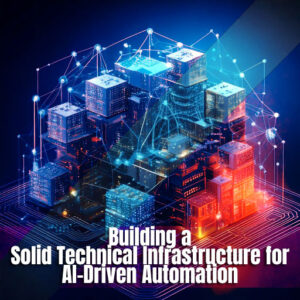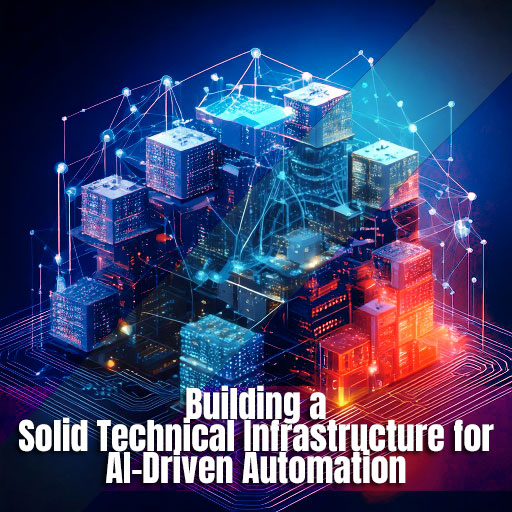 Building a Solid Technical Infrastructure for AI-Driven Automation
Building a Solid Technical Infrastructure for AI-Driven Automation
In today’s rapidly evolving digital landscape, organizations are looking to leverage AI-driven automation to transform their operations and maintain competitive advantage. However, the success of these initiatives depends heavily on having a robust technical infrastructure to support them.
Key Objectives for AI-Driven Technical Infrastructure
Scalable Computing Resources
AI systems require significant computational power, especially during training phases:
- Elastic computing capacity: Infrastructure must scale up during intensive processing periods and scale down during lower demand
- Processor optimization: Specialized hardware accelerators for machine learning workloads
- Distributed computing frameworks: Systems that can spread computational loads across multiple machines
Resilient Data Storage and Management
AI systems are data-hungry and require specialized storage solutions:
- High-throughput storage systems: Capable of handling large volumes of data at speed
- Data lakes and warehouses: Centralized repositories for structured and unstructured data
- Version control for data: Systems that track changes to datasets over time
Robust Networking Infrastructure
Data movement is critical for AI systems:
- Low-latency networks: Minimize delays in data transmission
- High bandwidth connections: Support large-scale data transfers
- Network redundancy: Ensure continuous operation even during partial outages
Comprehensive Security Framework
AI systems introduce new security considerations:
- Model protection: Safeguard trained models from theft or tampering
- Data encryption: Protect sensitive information throughout the AI pipeline
- Access controls: Ensure appropriate access to models and data
DevOps and MLOps Integration
Operational excellence for AI requires specialized processes:
- Automated CI/CD pipelines: Streamline deployment of AI models
- Model monitoring: Track performance and drift in production
- Experiment tracking: Document model versions and parameters
Preparing Your Organization for Success
Conduct a Technical Readiness Assessment
Before investing in new infrastructure:
- Evaluate current technical capabilities against AI requirements
- Identify performance bottlenecks and security vulnerabilities
- Assess the skills gap within technical teams
Develop a Strategic Roadmap
Plan your infrastructure evolution:
- Prioritize infrastructure upgrades based on business impact
- Create a phased implementation plan with clear milestones
- Establish key performance indicators for measuring success
Embrace Cloud and Hybrid Solutions
Leverage existing platforms:
- Consider cloud services for rapid scaling and reduced capital expenses
- Evaluate hybrid approaches that combine on-premises and cloud resources
- Explore specialized AI platforms from major cloud providers
Build Technical Expertise
Invest in your people:
- Upskill existing IT staff in AI infrastructure management
- Recruit specialists in areas like MLOps and data engineering
- Create collaborative teams that bridge AI expertise and infrastructure knowledge
Implement Infrastructure as Code
Ensure consistency and repeatability:
- Automate infrastructure provisioning and configuration
- Document infrastructure requirements in version-controlled code
- Enable rapid recovery and deployment across environments
Establish Governance Practices
Create guardrails for AI infrastructure:
- Develop policies for resource allocation and utilization
- Implement cost monitoring and optimization procedures
- Create standards for infrastructure security and compliance
Real-World Implementation Strategies
Organizations that successfully build AI-ready infrastructure typically follow these approaches:
- Start with pilot projects: Test infrastructure requirements with limited-scope AI initiatives
- Build modular systems: Design components that can be upgraded individually as needs evolve
- Monitor and optimize: Continuously evaluate infrastructure performance and make improvements
- Leverage partnerships: Work with vendors and consultants who specialize in AI infrastructure
Conclusion
Building a solid technical infrastructure for AI-driven automation is a foundational step in realizing the full potential of these technologies. By focusing on scalability, resilience, security, and operational excellence, organizations can create an environment where AI initiatives can thrive. The journey requires thoughtful planning, strategic investment, and ongoing commitment, but the results—increased agility, efficiency, and innovation capacity—deliver substantial competitive advantage in today’s digital economy. Contact us to see it in action.


